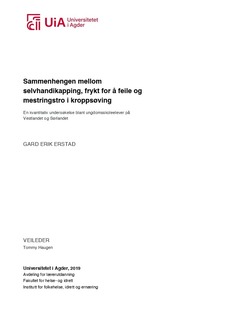| dc.contributor.author | Erstad, Gard Erik | |
| dc.date.accessioned | 2019-09-25T10:24:18Z | |
| dc.date.available | 2019-09-25T10:24:18Z | |
| dc.date.issued | 2019 | |
| dc.identifier.uri | http://hdl.handle.net/11250/2618700 | |
| dc.description | Master grunnskolelærerutdanning for trinn 5-10, 5-årig masterprogram IDR507 - Universitetet i Agder 2019 | nb_NO |
| dc.description.abstract | The purpose of this study was to gain more knowledge about the concepts of self-handicapping, self-efficacy and fear of failure in physical education, and also to investigate potential variation when it comes to school leveland gender among pupils in secondary school.The aimof thisstudy was twofold; 1) to investigate differences in the relevant concepts on the basis of school leveland gender and 2) to investigate relationships between the different concepts. Part 2 is more specifically related to examining the predictive ability of fear of failure and self-efficacy on self-handicapping. The study is a cross-sectionalstudy with a convenience sample consistingof 181 respondents from one secondary school in Western Norway and two secondary schools in Southern Norway. The results showed that the factorsare associated with each other. Fear of failure was significantly positively correlated with self-handicapping, while self-efficacy was significantly negatively correlated with self-handicapping. A regression analysis showed that fear of failure and self-efficacy predictedself-handicapping. High fear of failure wasassociated with higherself-handicapping while high self-efficacy was associated with lowerself-handicapping. On the basis of gender, girls had a significantly higher score on fear of failure than boys, while boys had a significantly higher score on self-efficacy. There wasno significant difference in self-handicapping based on gender. On the basis of school level(8th, 9thand 10th), the results showed that fear of failure had a significantly higher score in the 10thgradethan in the 8thand 9thgrades, while self-efficacy had a significantly lower score in the 10thgradethan in the 9thgrade. The present study gives information abouthow fear of failure, self-efficacy and self-handicapping are related in a physical educationsetting, as well as information about gender-and school level differences. Keywords: Physical education, quantitative research, self-handicapping, self-efficacy, fear of failure | nb_NO |
| dc.language.iso | nob | nb_NO |
| dc.publisher | Universitetet i Agder ; University of Agder | nb_NO |
| dc.rights | Attribution-NonCommercial-NoDerivatives 4.0 Internasjonal | * |
| dc.rights.uri | http://creativecommons.org/licenses/by-nc-nd/4.0/deed.no | * |
| dc.subject | IDR507 | nb_NO |
| dc.subject | kroppsøving | nb_NO |
| dc.subject | kvantitativ forskning | nb_NO |
| dc.subject | selvhandikapping | nb_NO |
| dc.subject | mestringstro | nb_NO |
| dc.subject | frykt for å feile | nb_NO |
| dc.subject | physical education | nb_NO |
| dc.subject | quantitative research | nb_NO |
| dc.subject | self-handicapping | nb_NO |
| dc.subject | self-efficacy | nb_NO |
| dc.subject | fear of failure | nb_NO |
| dc.title | Sammenhengen mellom selvhandikapping, frykt for å feile og mestringstro i kroppsøving : En kvantitativ undersøkelse blant ungdomsskoleelever på Vestlandet og Sørlandet | nb_NO |
| dc.type | Master thesis | nb_NO |
| dc.subject.nsi | VDP::Samfunnsvitenskap: 200::Samfunnsvitenskapelige idrettsfag: 330 | nb_NO |
| dc.source.pagenumber | 62 s. | nb_NO |

